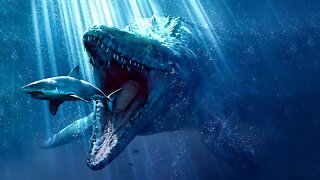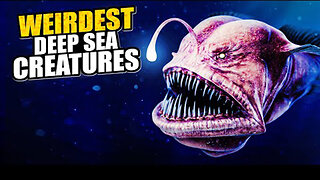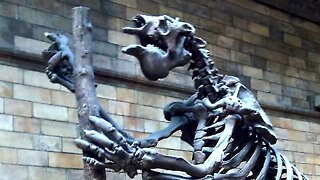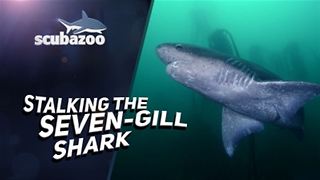Top 5 Prehistoric Sea Creatures The Government Wants To Bring Back To Life
Top 5 Prehistoric Sea Creatures The Government Wants To Bring Back To Life
Subscribe to Daily Dose Of Fact - https://bit.ly/2Z4b0m0
Here are the top 5 prehistoric sea creatures that the government is interested in bringing back to life, ranging from gigantic sharks to creepy marine reptiles. Starting off our list at number 5 is the Xiphactinus audax, a predatory fish that lived during the late Cretaceous Period about 85 million years ago. It was one of the largest bony fish ever recorded, growing up to 20 feet in length and weighing up to 1500 pounds. With its long and streamlined body, powerful jaws, and sharp teeth, it was capable of hunting and devouring smaller fish and marine reptiles. One of its unique skeletal adaptations was a hinged lower jaw that could open very wide, allowing it to swallow prey whole. Fossils of this fish have been found in North America, particularly in present-day Kansas and Alabama, as well as in Europe and South America. It is believed that this fish went extinct alongside the dinosaurs at the end of the Cretaceous Period, about 66 million years ago.
Taking the number 4 spot on our list today is a sea creature that goes by the name of the Godzilla shark. Despite its fearsome moniker, this creature, which lived roughly 300 million years ago, was anything but friendly. Fossils of this terrifying creature were discovered in 2013 by paleontologist John Paul Hodnett in the Zuni Mountains located to the east of Albuquerque, New Mexico. Picture a colossal shark, but with reptilian scales covering its body, 12 rows of razor-sharp teeth, and the largest dorsal fin spines of any known shark. That's right, you're imagining the Godzilla shark. The creature was named as such due to its monstrous appearance and resemblance to the famous movie monster. It was officially dubbed Hovasaurus boulei, which not only honors the family who owned the land where the skeleton was found but also acknowledges its terrifying and reptilian nature.
Taking the third spot on our list today is the Temnodontosaurus, an extinct marine reptile belonging to the ichthyosaur group. These creatures lived during the Jurassic period, about 180 to 150 million years ago. They were a formidable predator that could grow up to 33 feet or 10 meters long, thanks to their long and streamlined bodies that allowed them to swim swiftly through the water. Temnodontosaurus had a long snout filled with sharp teeth, which it likely used to hunt and eat fish and squid. According to fossil evidence, these creatures may have also been cannibalistic, with larger individuals preying on smaller ones. Unlike other reptiles, ichthyosaurs gave birth to live young rather than laying eggs. Several species of Temnodontosaurus have been identified, with T. platyodon being the most well-known. Fossils of this species have been found in Europe, particularly in Germany and the UK. T. platyodon had flattened teeth that were specialized for crushing the shells of its prey. Overall, these creatures were a fierce predator that dominated the Jurassic Seas, and their size and teeth made them a terrifying sight for any smaller creatures they encountered.
Taking the number 2 spot today are the Tylosaurus, members of the mosasaur family. With their long, eel-like bodies, they were able to glide smoothly through the water, and they possessed incredible bursts of speed to quickly catch their prey. Their large and robust snouts were a unique feature among mosasaurs, which may have been used to ram larger prey to stun them, giving the Tylosaurus the opportunity to finish them off with their powerful jaws. Despite this specialized hunting method, these predators were not very picky eaters, as their stomachs contained a variety of remains. The Tylosaurus was both larger and more agile than other mosasaurs, making it an ideal prehistoric predator.
Taking the top spot today is Helicocystis merkelsensis, a peculiar creature that roamed the Earth about 520 million years ago during the Cambrian Period. It had a spiral-shaped body and tentacles surrounding its mouth, making it look bizarre. Fossil remains of this animal were found in Morocco. It's believed that Helicocystis was a filter feeder, utilizing its tentacles to capture plankton from the water. The spiral shape of its body may have aided in controlling its buoyancy and helped it stay afloat in water. With its mouth located at the center of the spiral, the tentacles extended outward to capture food. Helicocystis is an essential species in studying early life on Earth because it belongs to a group of animals called echinoderms, which include modern-day sea stars, sea urchins, and sea cucumbers. The discovery of Helicocystis has led to a better understanding of the evolution and diversity of echinoderms.
#prehistoric #creatures #top10 #sea #deepsea #ocean #deepseacreatures #mostamazingtop10 #mysterious #creepy #history #ancienthistory #animals #science #backtolife #government #secrets
-
 7:07
7:07
Earth Titan
7 years agoTop 5 Deadliest Prehistoric Sea Creatures
150 -
 36:41
36:41
Seeker Land
1 year agoPrehistoric Sea Monsters - Age of the Dinosaurs - Full Documentary
331 -
 9:46
9:46
TopTierX
6 months agoTop 10 Terrifying Prehistoric Sea Creatures That Still Exist In Antarctica
27 -
 9:46
9:46
TopTierX
6 months agoTop 10 Terrifying Prehistoric Sea Creatures That Still Exist In Antarctica
45 -
 10:35
10:35
TopTierX
5 months agoCREEPY Prehistoric Sea Creatures That Still Exist In Antarctica
72 -
 7:08
7:08
Phuc102
1 year agoDiscovering the World's Most Elusive Aquatic Creatures
119 -
 9:25
9:25
Clip Creep
8 months agoTop 10 Terrifying Prehistoric Sea Monsters
8 -
 5:50
5:50
Earth Titan
6 years ago5 Prehistoric Creatures that Weren't Dinosaurs
19 -
 0:48
0:48
ZoominTVPetsandAnimals
7 years agoThe Mysterious Sevengill Sharks Are Dinosaurs Living Among Us
163K2 -
 1:14
1:14
WildCreatures
4 years ago $0.32 earnedThese Marine Iguanas of the Galapagos are just like mini dinosaurs
4.52K2